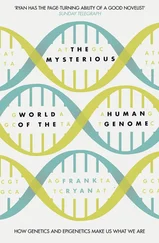Gary Marcus - Kluge - The Haphazard Construction of the Human Mind (Houghton Mifflin; 2008)
Здесь есть возможность читать онлайн «Gary Marcus - Kluge - The Haphazard Construction of the Human Mind (Houghton Mifflin; 2008)» весь текст электронной книги совершенно бесплатно (целиком полную версию без сокращений). В некоторых случаях можно слушать аудио, скачать через торрент в формате fb2 и присутствует краткое содержание. Жанр: Старинная литература, на английском языке. Описание произведения, (предисловие) а так же отзывы посетителей доступны на портале библиотеки ЛибКат.
- Название:Kluge: The Haphazard Construction of the Human Mind (Houghton Mifflin; 2008)
- Автор:
- Жанр:
- Год:неизвестен
- ISBN:нет данных
- Рейтинг книги:3 / 5. Голосов: 1
-
Избранное:Добавить в избранное
- Отзывы:
-
Ваша оценка:
- 60
- 1
- 2
- 3
- 4
- 5
Kluge: The Haphazard Construction of the Human Mind (Houghton Mifflin; 2008): краткое содержание, описание и аннотация
Предлагаем к чтению аннотацию, описание, краткое содержание или предисловие (зависит от того, что написал сам автор книги «Kluge: The Haphazard Construction of the Human Mind (Houghton Mifflin; 2008)»). Если вы не нашли необходимую информацию о книге — напишите в комментариях, мы постараемся отыскать её.
Kluge: The Haphazard Construction of the Human Mind (Houghton Mifflin; 2008) — читать онлайн бесплатно полную книгу (весь текст) целиком
Ниже представлен текст книги, разбитый по страницам. Система сохранения места последней прочитанной страницы, позволяет с удобством читать онлайн бесплатно книгу «Kluge: The Haphazard Construction of the Human Mind (Houghton Mifflin; 2008)», без необходимости каждый раз заново искать на чём Вы остановились. Поставьте закладку, и сможете в любой момент перейти на страницу, на которой закончили чтение.
Интервал:
Закладка:
E. E. (2005). Lifetime prevalence and age-of-onset distributions o/DSMIV disorders in the National Comorbidity Survey Replication. Chicago: American Medical Association.
Keysar, B., 8c Henly, A. S. (2002). Speakers' overestimation of their effectiveness. Psychological Science, 13(3), 207-12. King, M. C , 8c Wilson, A. C. (1975). Evolution at two levels in humans and chimpanzees. Science, 288(4184), 107-16.
Kirscht, J. P., Haefher, D. P., Kegeles, S. S., 8c Rosenstock, I. M. (1966). A national study of health beliefs. Journal of Health and Human Behavior, 7(4), 248-54.
Klauer, K. C , Musch, J., 8c Naumer, B. (2000). On belief bias in syllogistic reasoning. Psychological Review, 107(4), 852-84. Koehler, D. J. (1994). Hypothesis generation and confidence in judgment.
Journal of Experimental Psychology: Learning, Memory, and Cognition,
20(2), 461-69.
Koriat, A., Lichtenstein, S., 8c Fischhoff, B. (1980). Reasons for overconfidence. Journal of Experimental Psychology: Human Learning and Memory, 6, 107-18.
Kray, L. J., Galinsky, A. D., 8c Wong, E. M. (2006). Thinking within the box: The relational processing style elicited by counterfactual mind-sets. Journal of Personality and Social Psychology, 91, 33-48.
Kuhn, D. (2005). Education for thinking. Cambridge, MA: Harvard University Press.
Kuhn, D., 8c Franklin, S. (2006). The second decade: What develops (and how). In W. Damon 8c R. Lerner (Series Eds.), D. Kuhn 8c R. Siegler (Vol. Eds.), Handbook of child psychology (pp. 953-94). New York: Wiley.
Kunda, Z. (1990). The case for motivated reasoning. Psychological Bulletin, 108(3), 480-98.
Larrick, R. P. (2004). Debiasing. In D. Koehler 8c N. Harvey (Eds.), The Blackwell Handbook of Judgment and Decision Making (pp. 316-37). Maiden, MA: Blackwell.
Layard, P.R.G. (2005). Happiness: Lessons from a new science. New York: Penguin.
Leary, M. R., 8c Forsyth, D. R. (1987). Attributions of responsibility for collective endeavors. In C. Hendrick (Ed.), Group processes: Review of personality and social psychology, Vol. 8 (pp. 167-88). Thousand Oaks, CA: Sage.
Ledoux, J. E. (1996). The emotional brain: The mysterious underpinnings of emotional life. New York: Simon 8c Schuster.
Lerner, M. J. (1980). The belief in a just world: A fundamental delusion. New York: Plenum Press.
Leslie, S.-J. (2007). Generics and the structure of the mind. Philosophical Perspectives, 21(1), 378-403.
Liberman, N., Sagristano, M. D., 8c Trope, Y. (2002). The effect of temporal distance on level of mental construal. Journal of Experimental Social Psychology, 38(6), 523-34.
Lieberman, P. (1984). The biology and evolution of language. Cambridge, MA: Harvard University Press.
Linden, D. J. (2007). The accidental mind. Cambridge, MA: Belknap Press of Harvard University Press.
Linley, P. A., 8c Joseph, S. (2004). Positive change following trauma and adversity: A review. Journal of Traumatic Stress, 17(1), 11-21.
Lipman, M. (1970/1982). Harry Stottlemeier's discovery. Montclair, NJ: Institute for the Advancement of Philosophy for Children (IAPC).
Loftus, E. E (2003). Make-believe memories. American Psychologist, 58(11), 867-73.
Lord, C. G., Ross, L., 8c Lepper, M. R. (1979). Biased assimilation and attitude polarization: The effects of prior theories on subsequently considered evidence. Journal of Personality and Social Psychology, 37(11), 2098
109. Luria, A. K. (1971). Towards the problem of the historical nature of psychological processes. International Journal of Psychology, 6(4), 259-72.
Lynch Jr., J. G., & Zauberman, G. (2006). When do you want it?: Time, decisions, and public policy. Journal of Public Policy and Marketing, 25(1), 67-78.
Lyubomirsky, S., Caldwell, N. D., 8c Nolen-Hoeksema, S. (1998). Effects of ruminative and distracting responses to depressed mood on retrieval of autobiographical memories. Journal of Personality and Social Psychology 75(i), 166-77.
Macrae, C. N., Bodenhausen, G. V., Milne, A. B., 8c fetten, J. (1994). Out of mind but back in sight: Stereotypes on the rebound. Journal of Personality and Social Psychology, 67(3), 808-17.
Marcus, G. E (1989). The psychology of belief revision. Bachelor's thesis, Hampshire College, Amherst, MA. Marcus, G. F. (2004). The birth of the mind: How a tiny number of genes creates the complexities of human thought. New York: Basic Books. Marcus, G. E, 8c Wagers, M. (under review). Tree structure and the structure of sentences: A reappraisal. New York University.
Marks, I., 8c Nesse, R. (1997). Fear and fitness: An evolutionary analysis of anxiety disorders. In S. Baron-Cohen (Ed.), The maladapted mind: Classic readings in evolutionary psychopathology (pp. 57-72). Hove, UK: Psychology Press.
Markus, G. B. (1986). Stability and change in political attitudes: Observed, recalled, and "explained." Political Behavior, 8(1), 21-44. McClure, S. M., Botvinick, M. M., Yeung, N., Greene, J. D., 8c Cohen, J. D. (in
press). Conflict monitoring in cognition-emotion competition. In J. J. Gross (Ed.), Handbook of emotion regulation. New York: Guilford. Mealey, L. (1995). The sociobiology of sociopathy: An integrated evolutionary model. Behavioral and Brain Sciences, 18(3), 523-41.
Messick, D. M„ Bloom, S., Boldizar, J. P., & Samuelson, C. D. (1985). Why we are fairer than others. Journal of Experimental Social Psychology, 21(5), 480-500.
Meston, C. M., & Buss, D. M. (2007). Why humans have sex. Archives of Sexual Behavior, 36(4), 477-507. Metcalfe, J., & Shimamura, A. P. (1994). Metacognition: Knowing about knowing. Cambridge, MA: MIT Press.
Metzger, M. J., Flanagin, A. J., 8c Zwarun, L. (2003). College student Web use, perceptions of information credibility, and verification behavior. Computers and Education, 41(3), 271-90.
Miller, G., 8c Chomsky, N. A. (1963). Finitary models of language users. In
R. D. Luce, R. R. Bush, 8c E. Galanter (Eds.), Handbook of mathematical
psychology (Vol. II). New York: Wiley. Miller, G. F. (2000). Evolution of human music through sexual selection. In
N. L. Wallin, B. Merker, 8c S. Brown (Eds.), The origins of music (pp. 329-60). Cambridge, MA: MIT Press.
Minino, A. M„ Arias, E., Kochanek, K. D., Murphy, S. L., 8c Smith, B. L. (2002). Deaths: Final data for 2000. National Vital Statistics Report, 50(15), 1-119.
Mischel, W, Shoda, Y., 8c Rodriguez, M. I. (1989). Delay of gratification in children. Science, 244(4907), 933-38. Montague, R. (2006). Why choose this book?: How we make decisions. New York: Dutton. Montalbetti, M. M. (1984). After binding: On the interpretation of pronouns. Doctoral dissertation, MIT, Cambridge, MA.
Moseley, D., Baumfield, V., Higgins, S., Lin, M., Miller, J., Newton, D., Robson, S., Elliot, J., 8c Gregson, M. (2004). Thinking skill frameworks for post-16 learners: An evaluation. Newcastle upon Tyne, UK: Research Centre, School of Education.
Mussweiler, T., Strack, E, 8c Pfeiffer, T. (2000). Overcoming the inevitable anchoring effect: Considering the opposite compensates for selective accessibility. Personality and Social Psychology Bulletin, 26(9), 1142.
Nesse, R. (1997). An evolutionary perspective on panic disorder and agoraphobia. In S. Baron-Cohen (Ed.), The maladapted mind: Classic read
Читать дальшеИнтервал:
Закладка:
Похожие книги на «Kluge: The Haphazard Construction of the Human Mind (Houghton Mifflin; 2008)»
Представляем Вашему вниманию похожие книги на «Kluge: The Haphazard Construction of the Human Mind (Houghton Mifflin; 2008)» списком для выбора. Мы отобрали схожую по названию и смыслу литературу в надежде предоставить читателям больше вариантов отыскать новые, интересные, ещё непрочитанные произведения.
Обсуждение, отзывы о книге «Kluge: The Haphazard Construction of the Human Mind (Houghton Mifflin; 2008)» и просто собственные мнения читателей. Оставьте ваши комментарии, напишите, что Вы думаете о произведении, его смысле или главных героях. Укажите что конкретно понравилось, а что нет, и почему Вы так считаете.












